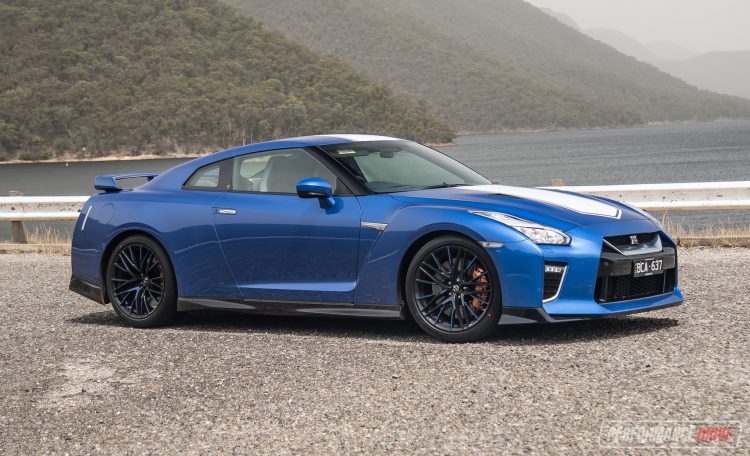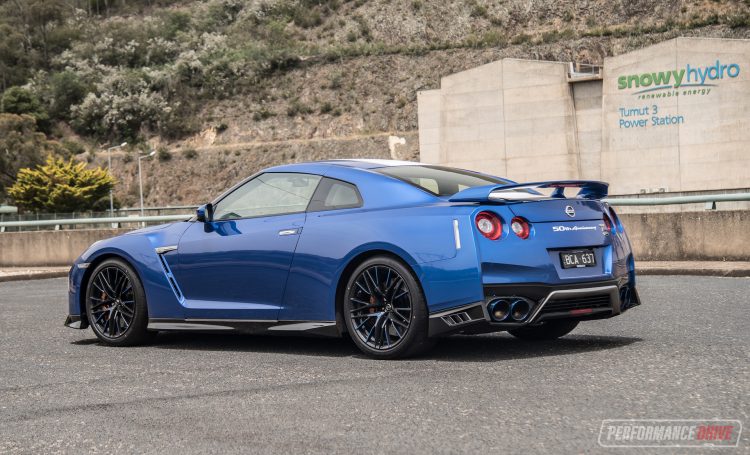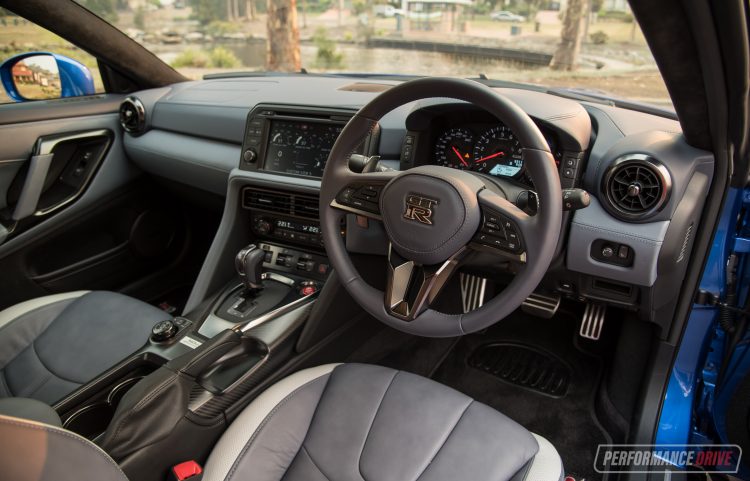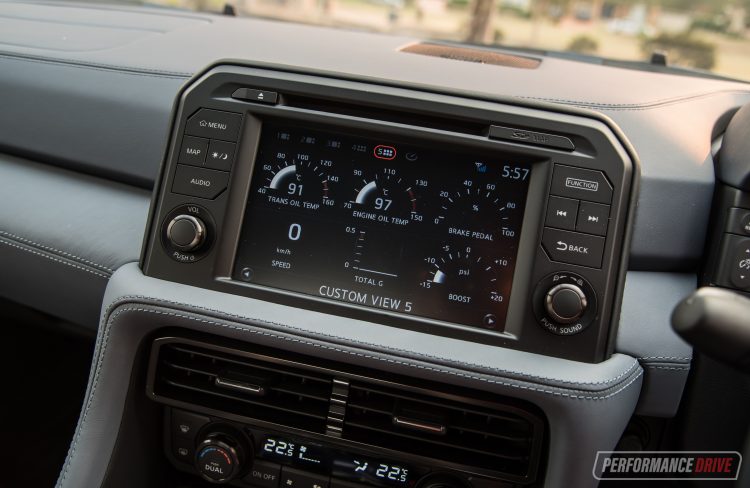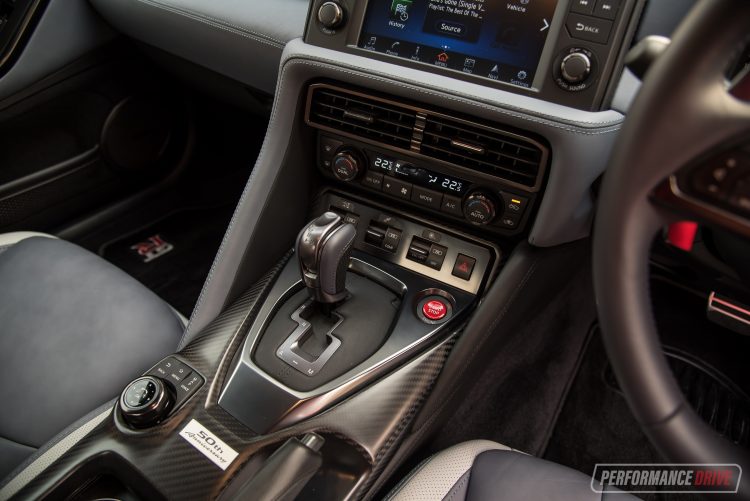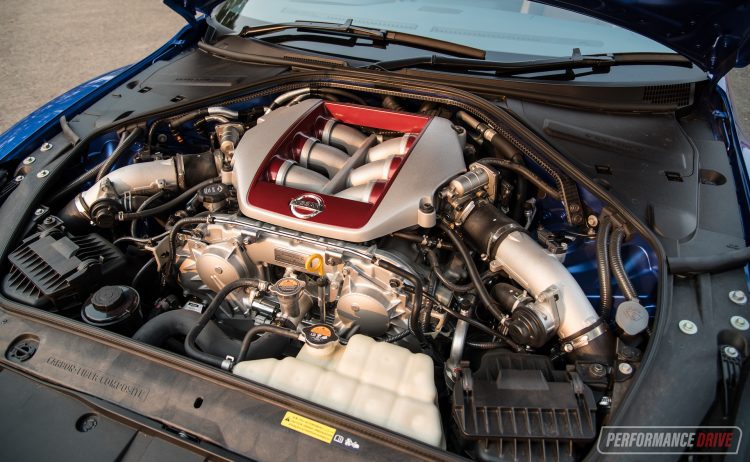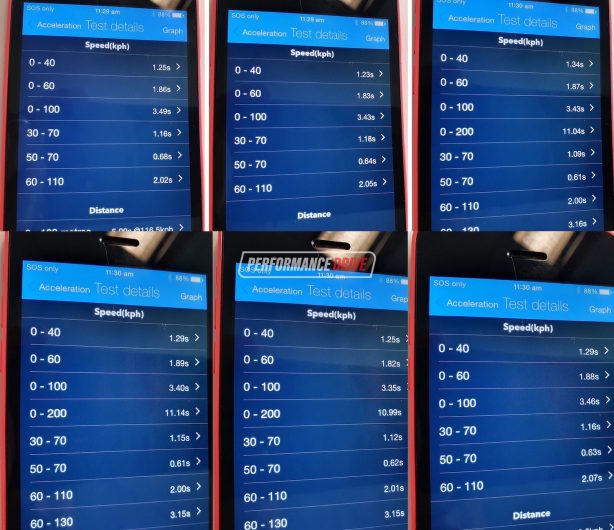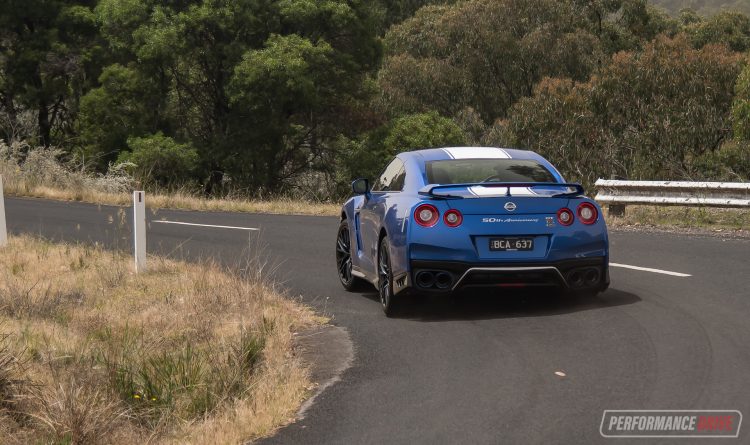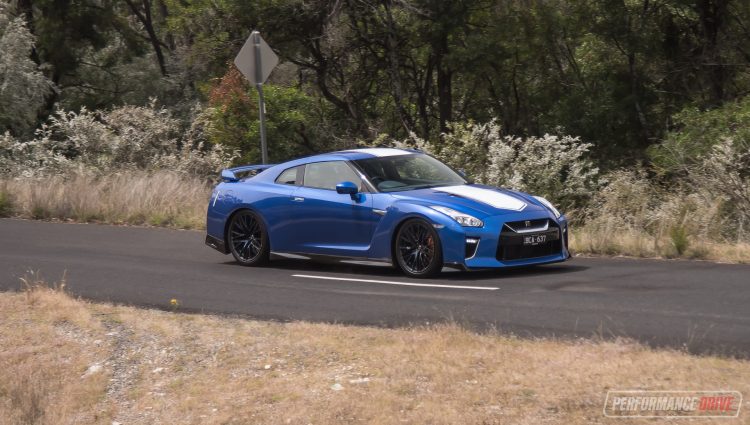This isn’t some new-kid-on-the-block showoff that has just entered the scene thinking it’s the best. The Nissan GT-R is a veteran. An expert at sports car-ing. It has been in this game for a long time and knows exactly what it’s doing. Even the R35 generation has over 10 years experience. Is this a good thing, though? Could it be time to hang up the gloves? Before you answer that, we should tell you Nissan has applied yet another update to the current shape model, for the introduction of the MY2020. And the company says it’s the biggest update since the 2017 model.
The GT-R nameplate celebrated its 50th anniversary last year, following the launch of the original model back in 1969. To mark the occasion the brand thought it would be a good idea to put together a special 50th Anniversary Edition. That’s what you’re looking at here. It sits in about the middle of the 2020 range, bookended by the GT-R Premium and Premium Luxury on the entry side, and the Track Edition and Track Edition with Nismo interior on the upper side. The 50th Anniversary Edition is based on the Premium Luxury and presents a similar personality and features.
It continues to be a very expensive car, the R35 GT-R. Despite its age. Prices span from $193,800 and go up to $247,000, excluding the separate, full-hypo Nismo version which retails from $378,000. Prices have hiked over the years. In fact, when the R35 launched in Australia in 2009 it was priced from $155,800.
With each update it seems the opening price just keeps climbing and climbing. We don’t agree with that. We think the prices should have dropped a bit by now, especially considering the initial engineering work has already been done. No doubt keen buyers won’t care about the price, and Nissan probably knows that.
2020 Nissan GT-R 50th Anniversary Edition – THE SPECS
[column width=”47%” padding=”6%”]Engine: 3.8-litre twin-turbo V6
Output: 419kW@6800rpm / 632Nm@3300-5800rpm
Transmission: Six-speed dual-clutch auto
Drive type: All-wheel drive
Wheels: F: 20×9.5, 255/40 R: 20×10.5, 285/35
ANCAP: Not tested
Kerb weight: 1765kg
Power-to-weight: 4.21:1 (kg:kW)
Official fuel economy: 12L/100km
Economy during test: 13.4L/100km
Fuel capacity/Type: 74L/98 RON[/column] [column width=”47%” padding=”0″]Power efficiency: 34.91kW:L/100km
0-60km/h: 1.82 seconds*
0-100km/h: 3.35 seconds*
60-110km/h: 2.01 seconds*
1/4 mile: 11.35 seconds at 203.3km/h*
Max acceleration: 1.432g
100-0km/h braking: 2.95 seconds at 36.92 metres*
Max deceleration: -1.589g
Decibel at idle: 57*
Peak decibel at 60-100km/h: 89*
Priced from: $209,300[/column][end_columns]
* Figures as tested by PerformanceDrive on the day. Factory claims may be different
2020 Nissan GT-R 50th Anniversary Edition – THE PACKAGE
If there was ever such a thing as a practical supercar, the R35 GT-R is as close as it gets. This does present something of a dilemma. On one hand, the presentation of the interior, the boot space, the controls and buttons, and the materials are just like those in a run-of-the-mill Nissan. A premium Nissan nonetheless, but still a Nissan. And for $200k, that might not be good enough for some buyers.
On the other hand you can enjoy a very high level of performance and theatre that’s otherwise only available from elite supercars, and you can enjoy it every day of the week; you can use the GT-R for commuting, picking up the kids, and even to do the shopping with. That’s not something you can comfortably do in a Ferrari or Lamborghini. Perhaps this versatility justifies the price?
With the 50th Anniversary Edition Nissan has tried to spruce up the interior and packaging to get it closer to its more exotic doppelgängers. Open the door and you’ll be struck by the two-tone grey and light grey leather upholstery, called Twilight Grey. It’s standard with the 50th edition. Yes, it could be seen as a bit vulgar and ostentatious. However, take a look at pretty much any exotic supercar and you’ll see a similarly-bright and high-impact presentation going on. If nothing else, this layout does help boost exclusivity and specialness for the Nissan.
Other than that, the GT-R interior is pretty conventional and almost boring. You’ve got an outdated 8.0-inch touch-screen media interface on the dash which doesn’t offer Android Auto or Apple CarPlay, or even digital radio. But Nissan has cleaned up the amount of buttons on the dash over the years to incorporate more functions into the screen, reducing clutter. We like that Nissan has left some important and regularly-used buttons around the screen though, to make things easy. Screen resolution doesn’t seem all that great, but the graphics, particularly within the performance readouts and gauges, are nice.
Down below the climate controls you’ll find the famous trio of driving modes. There’s a Race setting for the powertrain, suspension, and stability/traction control system. There’s also a separate Comfort mode for the suspension, and neutral modes for all. You can pick your favourite settings to suit the conditions while on the go.
Exclusive to the 50th Anniversary Edition is a badge, stating just that, on the centre console. A hand controller sits near, providing an easy-reach system for the navigation and most of the screen’s functions. It’s not quite as refined as Mazda’s MZD Connect or BMW’s iDrive system in our opinion, but it’s certainly better than no hand controller at all.
Passenger space and comfort in the front is good, provided you’re not really tall or fat. Remembering this is a coupe, you do need to bend down to get in, which may cause some complaints for some. But that’s just the way a coupe works. The doors are also long, but surprisingly not as long as some coupes on the market of similar size. Though, you do have to be careful in tight carparks during entry and egress all the same. Power-operated front seats are standard, which is convenient, and the singular control knob on the side is interesting compared with the common button layouts out there.
The rear seats are best left to children only. The cushioning and the length of the leg support portion is impressive, but the headroom is minimal and cut low by the rear windscreen. Due to the length of that leg support section, space for your legs to dangle over is seriously limited… unless a midget is driving or sitting in the front passenger seat. Nissan continues with the Fast & Furious inspired twin speakers for the middle seat, which is quite cool. They seem to help the GT-R connect with the street scene even more than it already does. And they provide good bass, paired in with the 11-speaker stereo by Bose.
While the rear seats are a bit of a mirage, the boot is the opposite. Nissan says there is 315 litres of volume on offer. It actually seems bigger than that, stretching in deep and spanning right to the far corners toward the back. It could probably gulp a set of golf sticks or other sporting equipment with ease.
Lastly, the exterior. No major changes are made for 2020 except for the special edition. Buyers can select between three colour schemes; Bayside Blue with white stripes (as featured here), Super Silver with white stripes, and Ivory Pearl (white) with red stripes. We’re not a big fan of this blue combo, even though it is inspired by the old Wangan Blue of the R34 GT-R. We think it’s a bit Ford Mustang. And the Mustang could be regarded as the arch nemesis in the Japanese car scene. Instead, we’d go for Ivory Pearl with red stripes, because at least they match the colours of the Japanese flag.
2020 Nissan GT-R 50th Anniversary Edition – THE DRIVE
Fire up the GT-R and it will instantly remind you of that classic Skyline sound. Nissan has fit a titanium exhaust for the 2020 model, which does produce a louder note at idle compared with the previous system (in-car idle 57dB vs 55dB, according to our tests). Give the throttle a tickle and you might even hear hints of inline six. Of course, there is no inline six under the bonnet anymore.
Instead, Nissan switched to a more compact 3.8-litre twin-turbo V6 with the R35. It remains in 2020, with a maximum power of 419kW at 6800rpm, and 632Nm between 3300-5800rpm. Some of the hardcore fans (like us) might be a bit disappointed Nissan hasn’t increased these outputs, even just a little, for the 2020 update.
And it’s even more strange when you get a load of all the revisions Nissan has made. The turbochargers are updated and now include something called abradable steel seals (a technology apparently taken from motorsport). These help to reduce leakage and improve low-end response, Nissan says. Looking at the stats, peak torque is available at the same rev range compared with the previous version.
Out on the road though the engine does feel slightly beefier, particularly in higher gears. While before you might change down from fourth to third gear for a big bend, now it seems like you can leave it in fourth without much complaint. If you watch our 0-100 video below, check out the in-car footage for the 60-110km/h run. We flatten the throttle in auto mode and the car’s brains tell the transmission to remain in third gear. There’s no excitement of the engine screaming from a downshift, but if you watch the speedo, it climbs very quickly indeed.
Other changes to the powertrain include revised transmission mapping in Race mode. Engineers have made it so the downchanges are more aggressive, even during activation of the anti-lock brakes. In other words, you can come cracking into a corner at mental speeds and pull the downshift paddle rapidly, and the transmission now does better to keep up with your tempo.
So then, the main sprints. Nissan claims 0-100km/h can happen in just 2.7 seconds. We, again, were not able to replicate this time. We even waited for cool conditions before testing (13 degrees). Using our Racelogic Vbox Sport and a private road the best we saw was 3.35 seconds, using the incredible launch control system (out of six runs; 3.49, 3.43, 3.43, 3.35, 3.40, 3.46). Across 0-200km/h the best run was an impressive 10.99 seconds. And then the quarter mile in 11.35 seconds at 203.3km/h. Although the 0-100km/h time isn’t as mind-bending as Nissan claims, the GT-R still produces the quickest real-world times we’ve ever tested in a four-seat production car. And that’s a pretty awesome feat considering the car’s veteran status.
Nissan has made some changes to the suspension for 2020 as well. It says it is smoother and offers a better ride. In the Comfort mode, we totally agree. The GT-R actually offers a pleasant ride, even compared with mild sports hatches. Some changes to the steering also mean it is less fidgety on the highway, requiring fewer minor corrections. We reckon it remains quite sharp and busy, albeit improved over the predecessor.
During at-the-limit driving in the mountains, we notice understeer does seem more prominent than before. Understeer is often regarded as the safer alternative to oversteer, but not as fun in our opinion. In the old model we remember being able to apply throttle and effectively powerslide the car into a drift. Now though, it seems to want to grip up and catapult when under power alone. It’s worth noting the same tyres carry across from the 2017 update; Dunlop SP Sport Maxx GT 600 DSST GTT, measuring 255/40 on the front and 285/35 on the back.
It would be interesting to see how the revised setup works on a track as the new suspension and steering would probably result in slight improvements to lap times. The changes made to increase engine response would likely help as well.
As a driver, you can now place more reliance on the brakes during heated driving. Nissan has made some changes to the pedal feel, and reduced the pedal’s compression stroke length. There’s also an upgraded brake booster and uprated steel for the discs. According to our Vbox data, this test car pulled up to a dead stop from 100km/h in 36.91 metres (best of three runs). That’s an improvement from 38.74m which we achieved in the 2017 model.
Obviously they are different cars with different tyres, and other variables also play a role, such as tyre wear. However, we found the results to be more consistent than before, with each of our three runs showing similar results in the 2020 car. Whereas the 2017 model produced more one-hit-wonders. Brake fade is noticeably reduced during repeated abuse.
Taking a closer look at all of these tested figures, it’s clear to see the GT-R offers astonishing all-round performance. Data shows the car can accelerate up to 100km/h in just 50 metres. That means, theoretically, you could sprint from 0-100-0 in well under 100 metres. That’s crazy, and it gives you some idea of the massive g-force this car puts you through. Of course, you don’t have to drive it at the limit like this each time you take off at the lights and come to a stop. But you know what we’re getting at.
Overall, the GT-R is still a beast of a machine. We love that it has a very distinct character. A distinct sound. And very distinct driving experience. It hasn’t copied any other car. Rather, it’s only copied and evolved from itself. That’s the magic of a legendary vehicle such as a GT-R. Not many rivals can boast such an extensive pedigree. Except, of course, the similarly-priced Porsche 911. Hmm.
2020 Nissan GT-R 50th Anniversary Edition – THE VIDEOS
2020 Nissan GT-R 50th Anniversary Edition – THE VERDICT
We love the GT-R. It definitely has a place somewhere prominent in our dream car garage. Not only does it offer very credible performance that’s been tried and tested, and evolved over decades, the GT-R nameplate has a certain ambience or even atmosphere that surrounds it. And it works like a magnetic field, drawing enthusiasts closer and closer. If you keep one for long enough, the value would likely go up and up, too. So there is some investment appeal here we think.
Compared with the more modern stuff that’s around nowadays, the GT-R is a bit crude, lacks safety tech, isn’t as savvy with in-car entertainment, and the design and interior decor is definitely behind the times. You could argue that it’s not exotic enough. But does all of this really matter? We don’t think so. Fans are going to continue to love it for what it is and what it stands for. However, we do think Nissan could show some courtesy and bring the price down a bit.
[column width=”47%” padding=”6%”]PROS:
– Epic all-round performance; capable of massive g-force in all directions
– Revised suspension provides good ride in Comfort mode
– New turbos improve low-end response
– Titanium exhaust is very cool
– Still one of the most practical supercars on the market
– Only supercar with a 5-year warranty
[/column] [column width=”47%” padding=”0″]CONS:
– Old touch-screen system
– Lacks modern safety tech
– Rear seats are an optical illusion
– Seems to understeer more than previous model
– Price needs to come down a bit[/column][end_columns]
As always, if you’re thinking about buying a new car don’t forget to click here to speak with our car buying specialists.
